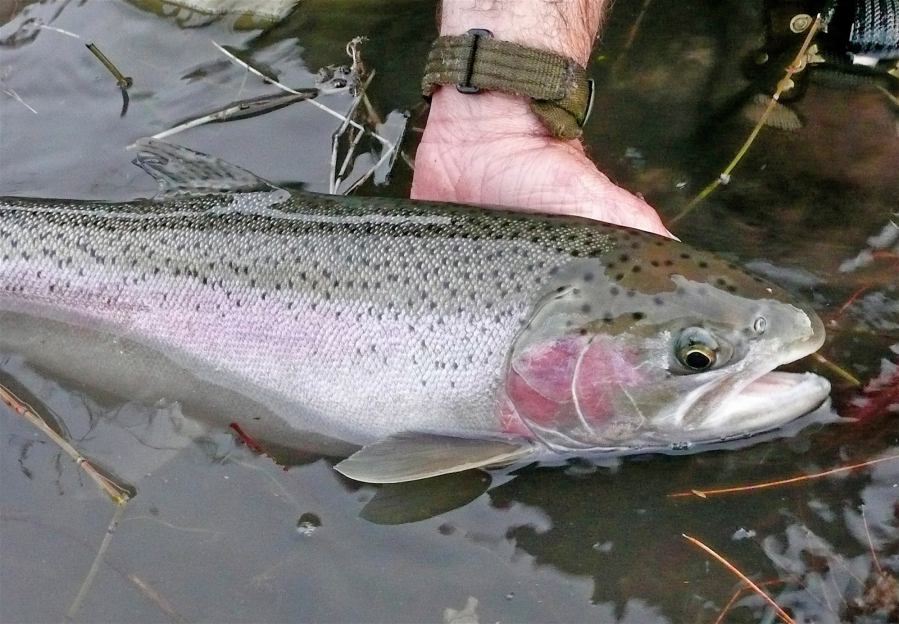By all accounts, 2017 was never supposed to be a banner year for steelhead.
The A-run is forecast to be a little better than last year’s dismal return — which some biologists called a complete year-class collapse — but still well below average. The B-run is expected to be terrible.
It’s too early to freak out, but counts of steelhead passing Bonneville Dam already are lagging behind those of 2016. Steelhead from the A-run, those that tend to spend just one year in the ocean, are arriving now and will be followed by the B-run in late August and September.
From June 1 through Tuesday, just shy of 4,000 steelhead had passed the dam. Last year, one of the worst on record for the A-run, more than 20,000 steelhead passed the dam in the same time period.
“If the counts don’t improve and we go along for three more weeks like we have been, then it’s time to start telling people this year is bad and it might be worse than we forecast, but we are nowhere near there yet,” said Alan Byrne, an Idaho Department of Fish and Game fisheries biologist at Boise. “The counts could still improve. The facts of the matter are the Bonneville counts are way below what our average counts are this time of year. But we are only a couple of weeks into the run. We won’t know the strength of the run until the first week of August.”
The preseason forecast calls for a return of 112,100 A-run steelhead to Bonneville Dam, including 33,000 wild fish and 79,100 hatchery fish. Those steelhead will be bound for various parts of the Columbia Basin, and about 50 percent of them are expected to head up the Snake River and pass over Lower Granite Dam.
Fisheries managers are expecting only 7,300 B-run steelhead to pass Bonneville Dam, including just 1,100 wild fish. About 70 percent of them are expected to return to the Snake River, which works out to about 4,340 hatchery and 770 wild Bs at Lower Granite Dam.
“We were fully expecting a very down B-run and not that great of an A-run, but better than last year,” said Joe DuPont, regional fisheries manager for the Idaho Department of Fish and Game. “Now it makes me a little uneasy.”
While the numbers of A-run steelhead counted at Bonneville are depressing, DuPont said there may be a glimmer of hope when you single out Idaho-bound hatchery fish. The numbers show the early part of the run is about average compared to those since 2010. But he cautioned the math is based on just two hatchery fish implanted with PIT tags that have passed Bonneville.
“What bothers me more is the big picture, when it’s more than just Idaho fish, when you are looking at all steelhead, counts over Bonneville are way down,” DuPont said.
It’s so low that you have to retreat to 1950 to find a year with a lower to-date steelhead count. Washington has implemented special rules in the Columbia River and many of its tributaries designed to protect B-run fish returning later this year, as well as A-run steelhead destined for the upper Columbia River. Idaho is monitoring the run and is prepared to implement restrictions designed to protect B-run steelhead in both the Clearwater and Salmon rivers.
Ron Roler said the low steelhead numbers mimic other data from this year’s salmon and steelhead runs. The Washington Department of Fish and Wildlife biologist at Olympia said spring chinook numbers were down, the Columbia River sockeye count is well below forecast and ocean fishing indicates a poor run of coho can be expected. A-run steelhead, coho and sockeye tend to spend just one year in the ocean before returning to fresh water to spawn. Last year, the poor ocean conditions and warm water blob of 2015 were blamed for the low returns. The ocean conditions have improved some, but Roler said it appears the change wasn’t fast enough to help fish returning this year.
Ocean anglers are catching good numbers of fall chinook, which Roler said may offer another glimmer of hope for fall fisheries.



